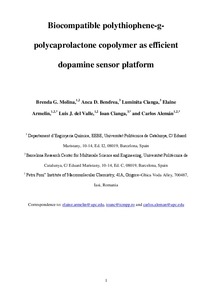Mostra el registre d'ítem simple
The biocompatible polythiophene-: G-polycaprolactone copolymer as an efficient dopamine sensor platform
| dc.contributor.author | Molina, Brenda G. |
| dc.contributor.author | Bendrea, Anca Dana |
| dc.contributor.author | Cianga, Luminita |
| dc.contributor.author | Armelín Diggroc, Elaine Aparecida |
| dc.contributor.author | Valle Mendoza, Luis Javier del |
| dc.contributor.author | Cianga, Ioan |
| dc.contributor.author | Alemán Llansó, Carlos |
| dc.contributor.other | Universitat Politècnica de Catalunya. Departament d'Enginyeria Química |
| dc.date.accessioned | 2017-11-10T07:46:44Z |
| dc.date.available | 2018-10-23T00:30:49Z |
| dc.date.issued | 2017-10-21 |
| dc.identifier.citation | Molina, B., Bendrea, A., Cianga, L., Armelin, E., del Valle, LJ., Cianga, Ioan, Aleman, C. The biocompatible polythiophene-: G-polycaprolactone copolymer as an efficient dopamine sensor platform. "Polymer chemistry", 21 Octubre 2017, vol. 8, núm. 39, p. 6112-6122. |
| dc.identifier.issn | 1759-9954 |
| dc.identifier.uri | http://hdl.handle.net/2117/110217 |
| dc.description.abstract | Amphiphilic copolymers consisting of an all conjugated polythiophene backbone and sparsely attached oligo-¿-caprolactone side chains have been prepared by anodic electropolymerization of hydroxymethyl-3,4-ethylenedioxythiophene (HMeEDOT) with a thiophene-ended oligo-¿-caprolactone macromonomer (Th-PCL), obtained by ring opening polymerization of ¿-caprolactone with thiophene methanol. The random copolymers, obtained starting from two different molar ratios of the co-monomers in the feed (HMeEDOT :&Th-PCL of 80&:&20 and 60&:&40), and the homopolymer (PHMeEDOT) were synthesized by using three different working electrodes. After structural characterization by FTIR, the electrochemical, morphological and surface properties of the obtained copolymers were examined, and the results evidenced a dependence on both the working electrode and the composition in the feed. In order to evaluate the opportunities in the copolymers's further bioapplications, biodegradability, cytotoxicity and cell proliferation investigations were carried out. By combining the results of electrochemical characterization with those of biocompatibility and dopamine sensing capability tests, it was concluded that a co-monomer feed ratio of 80&:&20 could be the optimal choice for the potential use of these amphiphilic copolymers in sensing devices. All in all, this study shows the benefit of a designed |
| dc.format.extent | 11 p. |
| dc.language.iso | eng |
| dc.subject | Àrees temàtiques de la UPC::Enginyeria química |
| dc.subject.lcsh | Ring-opening polymerization |
| dc.title | The biocompatible polythiophene-: G-polycaprolactone copolymer as an efficient dopamine sensor platform |
| dc.type | Article |
| dc.subject.lemac | Polimerització |
| dc.contributor.group | Universitat Politècnica de Catalunya. IMEM - Innovació, Modelització i Enginyeria en (BIO) Materials |
| dc.contributor.group | Universitat Politècnica de Catalunya. PSEP - Polimers Sintètics: Estructura i Propietats. Polimers Biodegradables |
| dc.identifier.doi | 10.1039/c7py01326d |
| dc.description.peerreviewed | Peer Reviewed |
| dc.relation.publisherversion | http://pubs.rsc.org/en/Content/ArticleLanding/2017/PY/C7PY01326D#!divAbstract |
| dc.rights.access | Open Access |
| local.identifier.drac | 21591968 |
| dc.description.version | Postprint (author's final draft) |
| local.citation.author | Molina, B.; Bendrea, A.; Cianga, L.; Armelin, E.; del Valle, LJ.; Cianga, Ioan; Aleman, C. |
| local.citation.publicationName | Polymer chemistry |
| local.citation.volume | 8 |
| local.citation.number | 39 |
| local.citation.startingPage | 6112 |
| local.citation.endingPage | 6122 |
Fitxers d'aquest items
Aquest ítem apareix a les col·leccions següents
-
Articles de revista [398]
-
Articles de revista [181]
-
Articles de revista [2.223]


